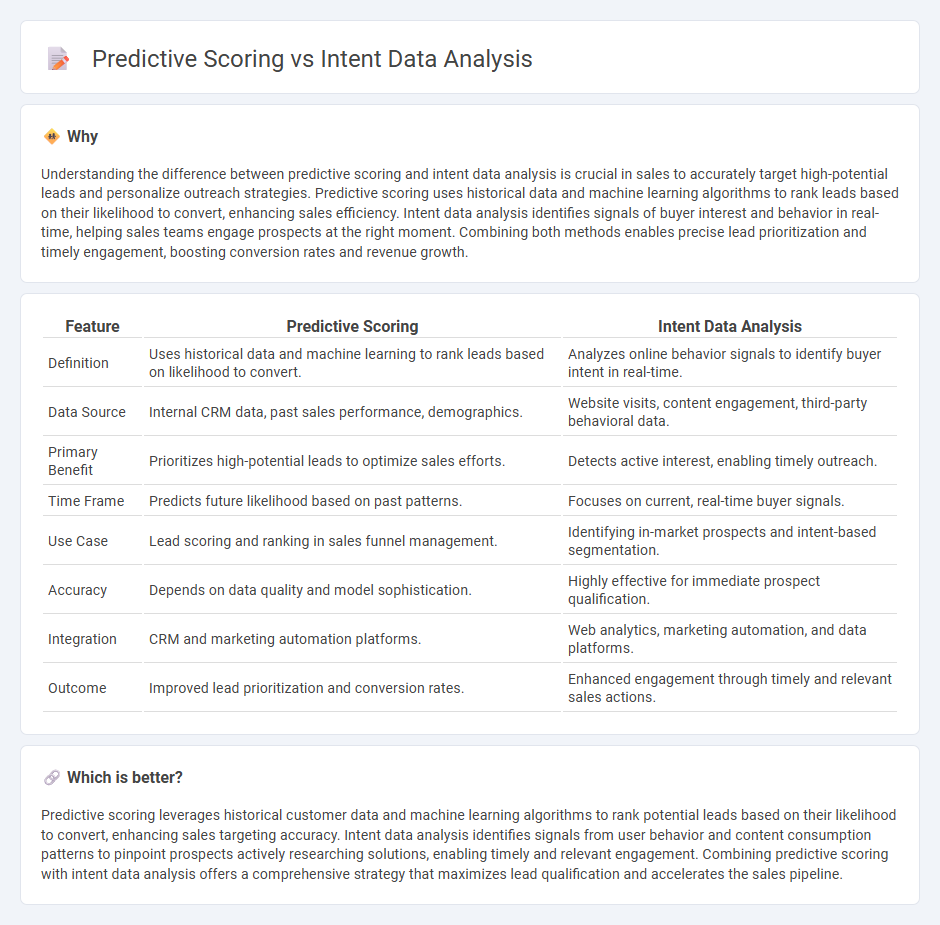
Predictive scoring leverages historical customer data and machine learning algorithms to rank leads by their likelihood to convert, enhancing sales efficiency. Intent data analysis focuses on monitoring online behaviors and signals to identify prospects actively researching products or services, allowing for timely engagement. Explore the distinctive advantages of predictive scoring and intent data analysis to optimize your sales strategy.
Why it is important
Understanding the difference between predictive scoring and intent data analysis is crucial in sales to accurately target high-potential leads and personalize outreach strategies. Predictive scoring uses historical data and machine learning algorithms to rank leads based on their likelihood to convert, enhancing sales efficiency. Intent data analysis identifies signals of buyer interest and behavior in real-time, helping sales teams engage prospects at the right moment. Combining both methods enables precise lead prioritization and timely engagement, boosting conversion rates and revenue growth.
Comparison Table
| Feature | Predictive Scoring | Intent Data Analysis |
|---|---|---|
| Definition | Uses historical data and machine learning to rank leads based on likelihood to convert. | Analyzes online behavior signals to identify buyer intent in real-time. |
| Data Source | Internal CRM data, past sales performance, demographics. | Website visits, content engagement, third-party behavioral data. |
| Primary Benefit | Prioritizes high-potential leads to optimize sales efforts. | Detects active interest, enabling timely outreach. |
| Time Frame | Predicts future likelihood based on past patterns. | Focuses on current, real-time buyer signals. |
| Use Case | Lead scoring and ranking in sales funnel management. | Identifying in-market prospects and intent-based segmentation. |
| Accuracy | Depends on data quality and model sophistication. | Highly effective for immediate prospect qualification. |
| Integration | CRM and marketing automation platforms. | Web analytics, marketing automation, and data platforms. |
| Outcome | Improved lead prioritization and conversion rates. | Enhanced engagement through timely and relevant sales actions. |
Which is better?
Predictive scoring leverages historical customer data and machine learning algorithms to rank potential leads based on their likelihood to convert, enhancing sales targeting accuracy. Intent data analysis identifies signals from user behavior and content consumption patterns to pinpoint prospects actively researching solutions, enabling timely and relevant engagement. Combining predictive scoring with intent data analysis offers a comprehensive strategy that maximizes lead qualification and accelerates the sales pipeline.
Connection
Predictive scoring leverages intent data analysis by evaluating potential buyers' behaviors and signals to forecast their likelihood to convert, improving sales targeting accuracy. Intent data, gathered from online activities such as content consumption and search patterns, feeds algorithms that generate predictive scores reflecting engagement levels and purchase readiness. This integration enables sales teams to prioritize leads more effectively, accelerating pipeline velocity and increasing close rates.
Key Terms
**Intent Data Analysis:**
Intent data analysis captures real-time behavioral signals indicating a prospect's interest and buying intent based on content consumption, search patterns, and engagement metrics. This granular insight helps identify high-potential leads earlier in the sales funnel, enabling personalized marketing strategies and improved conversion rates. Discover how intent data analysis can transform your lead generation and sales efforts.
Signals
Intent data analysis captures real-time behavioral indicators like content consumption and engagement patterns to identify potential buyers showing active interest. Predictive scoring uses historical data and machine learning algorithms to assign likelihood scores predicting future actions based on those intent signals. Explore how integrating intent signals with predictive scoring can enhance targeted marketing strategies and improve conversion rates.
Engagement
Intent data analysis captures real-time behavioral signals to identify prospects actively showing interest, enhancing targeting accuracy. Predictive scoring leverages historical data and machine learning algorithms to forecast future buyer behavior and prioritize leads based on engagement potential. Explore how combining intent data analysis with predictive scoring can optimize engagement strategies and boost conversion rates.
Source and External Links
What is Intent Data? How to Turn Signals Into Action - This article explains intent data as market intelligence identifying leads that are likely to buy, through online behaviors like website visits and keyword searches.
What Is B2B Intent Data? How to Get It, Use It, and More - This resource discusses B2B intent data, focusing on how it is collected and used to identify in-market accounts through sophisticated analysis of online content consumption.
Types of Intent Data (+How To Use Them) in B2B Marketing - This blog post highlights the benefits of intent data in B2B marketing, allowing businesses to identify and prioritize potential customers based on their online behaviors.
 dowidth.com
dowidth.com